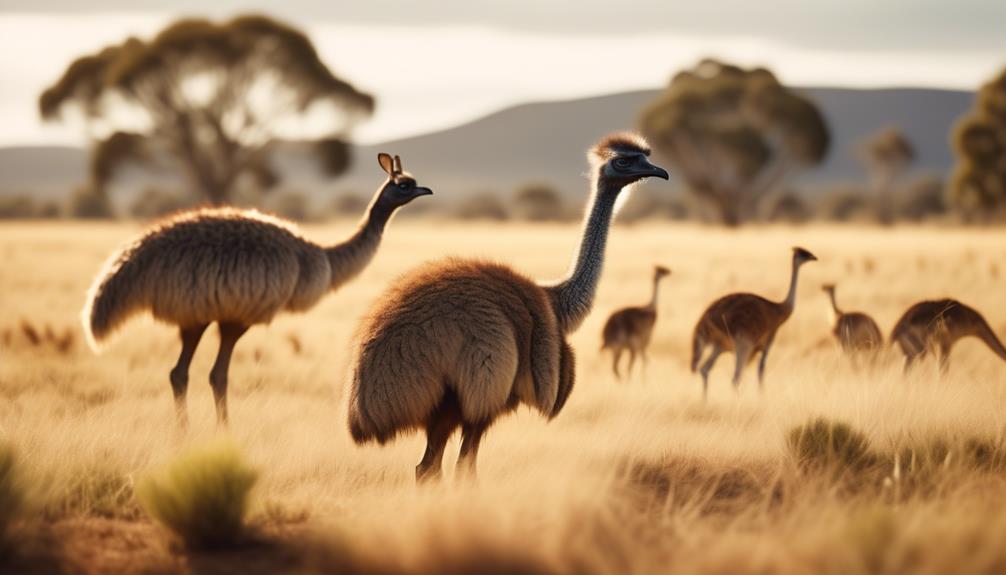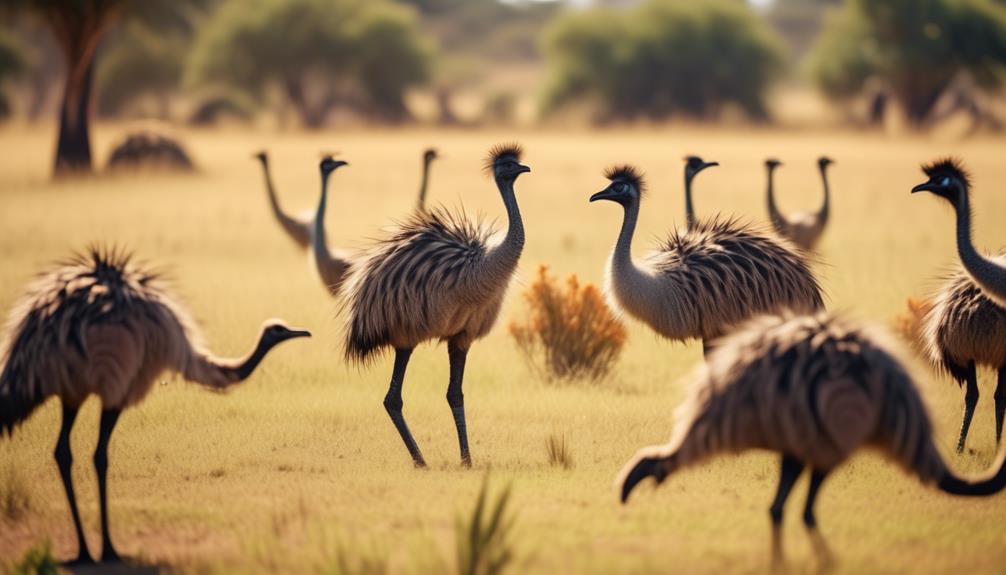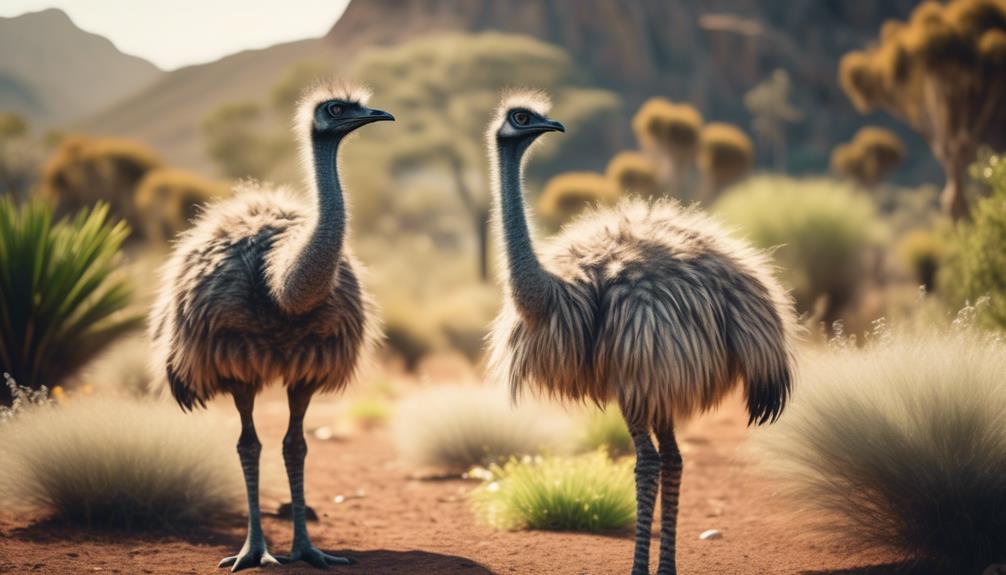
Imagine a vast, sprawling ecosystem teeming with life, where emus, the flightless giants of the bird world, roam freely. These seemingly ordinary creatures, with their long legs and curious demeanor, play a surprisingly vital role in maintaining the delicate balance of this ecological wonderland.
From their unique ability to disperse seeds to their influence on soil health and trophic cascades, emus possess an inherent power that goes beyond their physical presence. But what exactly is the extent of their impact? How do they shape the very fabric of these ecosystems?
In this exploration, we will uncover the intricate tapestry of the role of emus in ecosystems, offering an ecological perspective that unveils the significance of these enigmatic birds.
Key Takeaways
- Emus have a significant impact on vegetation dynamics through their feeding preferences and seed dispersal abilities.
- Emus play a crucial role in controlling insect populations and maintaining soil health through their foraging behavior.
- Interactions between emus and other herbivores can lead to changes in grazing patterns and vegetation composition.
- Emus contribute to the spread of native plant species and play a vital role in biodiversity conservation and ecosystem health.
Emus as Seed Dispersers
Emus play a crucial role in ecosystems as seed dispersers. Their impact on plant regeneration can't be underestimated. Emus consume a diverse range of plant material, including fruits, seeds, and leaves. This varied diet allows them to ingest and subsequently disperse a wide variety of seeds, contributing to the dispersal of plant species across their habitat.
The relationship between emu diet and seed dispersal effectiveness is an area of ongoing research. Studies have shown that emus have the ability to consume and disperse seeds of various sizes, thanks to their unique digestive system. Emus have a large, muscular gizzard that helps break down food, including seeds, allowing them to pass through their digestive tract intact. This enables the seeds to be dispersed over long distances, increasing the chances of successful plant establishment and colonization.
Furthermore, emus are known to preferentially consume fruits and seeds that are rich in nutrients, which may enhance the chances of successful seed germination and plant growth. By selectively feeding on certain plant species, emus can influence the composition and structure of plant communities, shaping the overall biodiversity of their environment.
Impact of Emus on Vegetation Dynamics
What is the impact of emus on vegetation dynamics in their habitat?
Emus, as large herbivores, play a significant role in shaping vegetation dynamics within their ecosystem. Their foraging behavior and feeding preferences directly influence the composition, structure, and distribution of plant species. Emus have a particular fondness for grasses and small shrubs, which they consume in large quantities. This selective feeding behavior can lead to changes in plant community composition, favoring certain species over others.
Furthermore, emus contribute to the dispersal of plant seeds through their consumption of fruits and subsequent excretion. This process aids in the spread and establishment of plant species, contributing to the overall diversity and resilience of the ecosystem. Emus also have a significant impact on vegetation dynamics during periods of ecosystem disturbances, such as wildfires or droughts. Their ability to consume large volumes of vegetation allows them to act as natural regulators, reducing fuel loads and preventing the spread of fires.
In the context of climate change, emus may play a crucial role in shaping vegetation dynamics. As climate patterns shift and become more unpredictable, emus' feeding preferences and foraging behavior may adapt accordingly, influencing the distribution and abundance of plant species. Understanding the impact of emus on vegetation dynamics is vital for effective ecosystem management and conservation efforts, ensuring the long-term stability and resilience of these ecosystems in the face of current and future challenges.
Emus' Role in Controlling Insect Populations

The impact of emus on vegetation dynamics extends beyond their influence on plant species composition and distribution, as they also play a significant role in controlling insect populations within their habitat. Emus' role in controlling insect populations is essential for the overall health and balance of the ecosystem.
Here are three key ways in which emus contribute to this:
- Consumption of insects: Emus are opportunistic feeders and consume a wide variety of insects, including grasshoppers, beetles, and spiders. By actively foraging for these insects, emus help to regulate their populations, preventing outbreaks that could harm the vegetation and disrupt the ecosystem.
- Emus' role in pollination: While emus primarily consume insects, they also inadvertently contribute to pollination. As they move through their habitat, emus can transfer pollen from one plant to another, aiding in the reproductive processes of various plant species. This indirect pollination helps to maintain the diversity and health of the vegetation.
- Emus' impact on water availability: Emus play a role in controlling insect populations, which in turn affects the water availability in their habitat. By controlling the numbers of insects that feed on vegetation, emus indirectly contribute to the conservation of water resources. This is because excessive insect feeding can lead to plant damage, reducing the overall transpiration rates and resulting in water loss.
Emus and Their Influence on Soil Health
Emus' presence in an ecosystem has a significant impact on the health and fertility of the soil. These large flightless birds play a crucial role in nutrient cycling, which is essential for maintaining a balanced and productive soil environment.
Emus contribute to the nutrient cycling process by consuming various plant materials and depositing their droppings throughout the ecosystem. This process, known as defecation, introduces essential nutrients back into the soil, such as nitrogen, phosphorus, and potassium. These nutrients are then made available to plants, promoting their growth and overall health.
Furthermore, emus also have a unique relationship with soil microorganisms. These microorganisms, including bacteria and fungi, are responsible for breaking down organic matter and releasing nutrients for plant uptake. Emus' foraging behavior disturbs the soil surface, creating opportunities for microorganisms to thrive and enhance nutrient cycling.
The emus' scratching and pecking also aids in the decomposition of plant material, accelerating the breakdown process and releasing valuable nutrients into the soil.
Interactions Between Emus and Other Herbivores

Interactions between emus and other herbivores play a crucial role in shaping the dynamics of the ecosystem. These interactions are multifaceted, with both positive and negative outcomes. Let's explore three key aspects of the interactions between emus and other herbivores:
- Competition for resources: Emus, being large herbivores, compete with other herbivores such as kangaroos and wallabies for food. This competition can lead to changes in grazing patterns and vegetation composition, ultimately affecting the overall structure and composition of the ecosystem.
- Interactions with predators: Emus, being flightless birds, have developed strategies to defend themselves against predators. Their presence in an area can influence the behavior and distribution of predators, as they may avoid areas with a high emu population. This indirect influence can have cascading effects on predator-prey dynamics within the ecosystem.
- Impact on water sources: Emus have a significant impact on water sources within their habitat. They're known to dig shallow waterholes, especially during dry periods, which can benefit other herbivores by providing access to water. However, excessive digging by emus can also lead to water loss through evaporation and soil erosion, affecting the availability and quality of water for other species.
Understanding these interactions between emus and other herbivores is essential for comprehending the complexity of ecosystems and implementing effective conservation strategies.
Emus and the Spread of Native Plant Species
Comprehending the multifaceted interactions between emus and other herbivores allows for a deeper understanding of the role emus play in shaping the spread of native plant species within ecosystems. Emus, as large herbivores, have a significant impact on the distribution and abundance of native plant species. Their feeding behavior and movement patterns influence the dispersal of seeds, leading to the establishment of new populations of native plants.
One important aspect to consider is the relationship between emus and climate change. As climate patterns shift, certain plant species may become more or less dominant in different regions. Emus, with their ability to consume a wide variety of plant material, can help facilitate the spread of native plant species that are better adapted to changing environmental conditions. They act as seed dispersers, carrying seeds in their digestive tracts and depositing them in new areas through their droppings. This allows for the colonization of suitable habitats by native plant species, contributing to their overall resilience in the face of climate change.
Additionally, emus play a role in fire ecology. They've been observed consuming the fruits of fire-adapted plant species, which contain hard-coated seeds that are released and germinate after a fire event. By consuming these fruits, emus aid in the dispersal of fire-tolerant plant species, facilitating their regeneration and the recovery of ecosystems after fire. This interaction highlights the interconnectedness between emus, fire, and the spread of native plant species.
Emu Feeding Habits and Ecosystem Resilience

The feeding habits of emus contribute to the resilience of ecosystems by shaping the distribution and abundance of native plant species. Emu foraging behavior and its impact on ecosystem structure play a crucial role in maintaining the balance and functionality of these environments. Understanding the grazing patterns of emus and their effects on plant community composition is essential for effective ecosystem management.
Here are three key ways in which emu feeding habits influence ecosystem resilience:
- Seed dispersal: Emus consume a wide variety of plant species and disperse their seeds through their droppings. This process aids in the dispersal and colonization of native plants, promoting genetic diversity and the establishment of new populations.
- Vegetation control: Emus are selective grazers, targeting specific plant species while leaving others untouched. This selective feeding behavior helps control the growth and distribution of vegetation, preventing the dominance of any single species and promoting a diverse plant community.
- Soil disturbance: Emus use their strong legs and beaks to dig into the ground in search of food. This digging behavior creates patches of disturbed soil, which can enhance nutrient cycling, promote seed germination, and create microhabitats for other organisms.
The Importance of Emus for Biodiversity Conservation
Emus play a critical role in biodiversity conservation by contributing to the maintenance and preservation of species richness and ecological balance within ecosystems. These flightless birds have a significant impact on water resources as they aid in the dispersal of seeds through their consumption of various fruits and plants. When emus consume these fruits and plants, they subsequently excrete the undigested seeds, which then germinate and grow into new vegetation. This process helps to maintain and restore plant diversity, ensuring the survival of numerous species within the ecosystem.
Furthermore, emus have a unique relationship with apex predators in their habitat. While they aren't typically preyed upon by these predators, emus indirectly benefit them by providing a source of food. As emus forage on vegetation, they disturb insects and small animals that also inhabit the area. Apex predators, such as large birds of prey or carnivorous mammals, take advantage of this disturbance to capture their prey. Thus, emus indirectly contribute to the overall balance and stability of the predator-prey dynamics within the ecosystem.
Emus as Indicator Species for Ecosystem Health

By examining the role of emus in maintaining biodiversity and ecological balance, one can gain insight into their potential as indicator species for assessing ecosystem health. Emus, with their large size and wide-ranging habitat, play a crucial role in maintaining the balance of ecosystems. They're known as bioindicators, as their presence or absence can reflect the overall health of an ecosystem.
Here are three reasons why emus can serve as effective indicators of ecosystem health:
- Sensitivity to environmental changes: Emus are highly sensitive to changes in their environment. They rely on specific vegetation types for food and shelter, and any alterations in these habitats can impact their survival. By monitoring emu populations, scientists can detect changes in the ecosystem that might otherwise go unnoticed.
- Indicator of habitat quality: Emus require large tracts of land with diverse vegetation to thrive. The presence of healthy emu populations indicates the availability of suitable habitat and the presence of a functioning ecosystem. Conversely, a decline in emu numbers suggests degraded habitat and potential ecosystem disruption.
- Ecosystem services: Emus provide important ecosystem services, such as seed dispersal and nutrient cycling, which contribute to overall ecosystem health. By studying the behavior and population dynamics of emus, researchers can gain insights into the functioning of these vital ecological processes.
Understanding the role of emus as bioindicators and the ecosystem services they provide can help us assess the health of ecosystems and guide conservation strategies. By protecting and monitoring emu populations, we can ensure the preservation of these unique and valuable indicators of ecosystem health.
Emus and Their Role in Trophic Cascades
Studying the impact of emus on trophic cascades provides valuable insights into the ecological dynamics of their ecosystems. Emus, as large herbivores, play a crucial role in shaping predator-prey relationships and nutrient cycling within their habitats.
Emus have a significant impact on predator-prey relationships. As herbivores, they consume large quantities of vegetation, altering the availability of food for herbivorous prey species, such as rabbits and kangaroos. This reduction in herbivore populations can have cascading effects on predator populations, as predators may struggle to find sufficient prey for sustenance. Consequently, the presence or absence of emus can influence the abundance and distribution of predators within the ecosystem.
Emus also contribute to nutrient cycling within their habitats. Through their feeding behavior, emus redistribute nutrients by consuming and excreting plant matter. This process enhances nutrient availability in the soil, promoting plant growth and productivity. Additionally, emus aid in seed dispersal by ingesting seeds, which are then deposited in their droppings at different locations, facilitating plant colonization and diversity.
To illustrate the impact of emus on predator-prey relationships and nutrient cycling, consider the following table:
| Emus' Impact | Predator-Prey Relationships | Nutrient Cycling |
|---|---|---|
| Positive | Emus reduce herbivore populations, influencing predator populations | Emus redistribute nutrients and aid in seed dispersal, enhancing plant growth and diversity |
Understanding the intricate interactions between emus, predator-prey relationships, and nutrient cycling is vital for effective ecosystem management and conservation. By studying trophic cascades involving emus, we can gain a deeper understanding of the complex dynamics that sustain these ecosystems.
Frequently Asked Questions
How Fast Can Emus Run?
Emus are impressive runners, capable of reaching speeds up to 30 miles per hour. Their swift pace plays a crucial role in their migration patterns and contributes to the overall dynamics of the ecosystems they inhabit.
What Is the Average Lifespan of an Emu in the Wild?
On average, emus in the wild have a lifespan of around 10 to 20 years. This is influenced by various factors such as emu population size, breeding habits, and environmental conditions.
Do Emus Have Any Natural Predators?
Emus, like any other animal, have natural predators. Despite their large size, emus serve as prey in predator-prey dynamics, facing threats from animals such as dingoes and large raptors.
How Do Emus Communicate With Each Other?
Emus communicate with each other through a combination of vocalizations and visual displays. These signals allow them to convey information about their intentions, territory, and social status, fostering cohesion within their group.
Are Emus Found in Any Other Parts of the World Besides Australia?
Yes, emus are found in other parts of the world besides Australia. However, when they become invasive species, they can have a significant impact on local biodiversity. Their presence should be carefully managed.
Conclusion
In conclusion, the emu plays a multifaceted and crucial role in ecosystems. Symbolically representing resilience and adaptability, this remarkable bird acts as a seed disperser, shapes vegetation dynamics, controls insect populations, influences soil health, interacts with other herbivores, and contributes to the conservation of biodiversity.
Furthermore, the emu serves as an indicator species, reflecting the overall health of an ecosystem. With its vital position in trophic cascades, the emu exemplifies the interconnectedness and delicate balance of nature.




